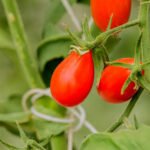What flowers are good next to vegetable gardens? When it comes to creating a thriving and visually appealing vegetable garden, the inclusion of companion flowers can make all the difference. By strategically selecting the right flowers, gardeners can attract beneficial insects and pollinators, repel pests, and improve soil health. In this article, we will explore how incorporating flowers in a vegetable garden not only enhances its beauty but also provides various benefits for overall garden success.
One of the key aspects we will delve into is the significant benefits of companion planting. We will discuss how certain flowers can attract essential pollinators like bees and butterflies, as well as repel common pests that may threaten the growth of vegetables. Additionally, we will highlight the role of flowers in improving soil health and creating a more balanced ecosystem within the garden.
In our guide to choosing the right flowers for a vegetable garden, we will provide valuable insights on selecting flowers that complement and support the growth of vegetables. Understanding the specific sunlight and soil requirements of these flowers is essential for ensuring they thrive alongside vegetables.
We will also offer tips on vertical gardening with flowers to maximize space and add visual interest to the garden. Whether you’re new to gardening or a seasoned enthusiast, this article aims to equip you with practical knowledge on incorporating flowers into your vegetable garden for both aesthetic appeal and functional benefits.
Benefits of Companion Planting
Companion planting, the practice of growing different plants in close proximity to one another for mutual benefit, offers numerous advantages when flowers are integrated into a vegetable garden. One of the key benefits of companion planting with flowers is the ability to attract beneficial insects and pollinators.
Bees, butterflies, and other pollinators are vital for the successful reproduction of many vegetables, and by including nectar-rich flowers in the garden, these essential insects are encouraged to visit and help with pollination.
In addition to attracting pollinators, certain flowers can also play a crucial role in repelling pests that may otherwise damage vegetable crops. For example, marigolds are known for their ability to deter nematodes in the soil, while nasturtiums can keep aphids away from nearby plants. By strategically selecting and placing pest-repelling flowers throughout the vegetable garden, growers can naturally protect their crops without relying on harmful chemicals.
Furthermore, incorporating flowers into a vegetable garden can contribute to improved soil health. Some flowers have deep root systems that help break up compacted soil, while others add organic matter when they decompose. Additionally, certain flowers like clover have nitrogen-fixing properties that can enrich the soil with this essential nutrient. Overall, companion planting with flowers not only enhances the aesthetic appeal of the garden but also provides practical benefits for both plants and soil health.
Choosing the Right Flowers
When selecting flowers to complement and support the growth of vegetables in a garden, it is important to consider which flowers will provide the most benefit. Here are some key factors to consider when choosing the right flowers for your vegetable garden:
- Complementary growth habits: Look for flowers that have similar growth habits to your vegetables. For example, tall flowers such as sunflowers or hollyhocks can provide shade and support for sprawling plants like squash or cucumbers.
- Bloom time: Choose flowers that bloom at different times throughout the growing season to ensure continuous attraction of beneficial insects and pollinators. This can help with cross-pollination and improve overall garden health.
- Soil compatibility: Consider the soil requirements of both your vegetables and the flowers you plan to plant. Some flowers may prefer different soil pH levels or drainage conditions than your vegetables, so it’s important to choose compatible varieties.
In addition to these factors, it’s also helpful to select flowers that offer specific benefits to the vegetable garden, such as attracting pollinators or repelling pests. Flowers like marigolds, nasturtiums, and calendula are known for their pest-repelling properties, while bee balm, lavender, and coneflowers are excellent for attracting pollinators.
By carefully selecting the right flowers for your vegetable garden based on these considerations, you can create a harmonious environment where both plants thrive and support each other’s growth. As a result, you’ll enjoy not only a more visually appealing garden but also improved overall productivity and health of your crops.
Sunlight and Soil Requirements
When selecting flowers to plant alongside your vegetables, it is crucial to consider their sunlight and soil requirements. Just like vegetables, different flowers have specific needs for sunlight exposure and soil composition to thrive. Understanding these requirements is essential for ensuring the success of companion planting in your vegetable garden.
Some flowers, such as sunflowers and marigolds, require full sun exposure to bloom and grow vigorously. On the other hand, shade-loving flowers like impatiens and begonias can thrive in partial or dappled sunlight. It is important to assess the sunlight levels in different areas of your garden to determine which flowers will flourish best alongside your vegetables.
In addition to sunlight, soil quality plays a significant role in the growth and development of flowers. Some flowers prefer well-draining soil with a sandy or loamy texture, while others thrive in more compact or moisture-retentive soil. Before planting flowers next to your vegetables, it is advisable to test the soil pH and fertility levels to ensure that it meets the specific needs of the selected flower varieties.
| Flower Variety | Sunlight Needs | Soil Preferences |
|---|---|---|
| Sunflower | Full Sun | Well-Draining Loamy Soil |
| Marigold | Full Sun | Rich, Moist Soil |
| Impatiens | Partial Shade | Moist, Well-Draining Soil |
Best Flowers for Attracting Pollinators
Bees, butterflies, and other beneficial insects play a crucial role in pollinating vegetable crops, ultimately leading to a bountiful harvest. Choosing the right flowers to attract these pollinators is essential for the success of a vegetable garden. Some of the best flowers for attracting pollinators include sunflowers, lavender, and wild bergamot. These flowers not only add beauty to the garden but also provide nectar and pollen that will entice bees and butterflies.
Sunflowers are not only a stunning addition to any garden but are also highly attractive to bees. Their bright yellow color and large size make them easily visible to pollinators. Lavender is another great option as it produces fragrant blooms that are irresistible to both bees and butterflies.
In addition, its aromatic foliage can help repel unwanted pests in the vegetable garden. Wild bergamot, also known as bee balm, is loved by bees due to its tubular-shaped flowers filled with nectar.
Incorporating these pollinator-attracting flowers into a vegetable garden not only enhances its visual appeal but also ensures that there will be sufficient pollination for a successful harvest. By providing an abundant source of nectar and pollen, these flowers contribute to the overall health and biodiversity of the garden ecosystem.
| Flower | Pollinators Attracted |
|---|---|
| Sunflower | Bees |
| Lavender | Bees, Butterflies |
| Wild Bergamot (Bee Balm) | Bees |
Pest-Repelling Flowers
When it comes to protecting your vegetable garden from common pests, incorporating pest-repelling flowers can be a natural and effective solution. By strategically planting flowers that naturally deter pests, you can help safeguard your vegetables from damage without the need for harmful chemicals. Here are some options for identifying flowers that can serve as a natural pest control in your garden:
- Marigolds: These colorful and vibrant flowers are known for their ability to repel nematodes, beetles, and other destructive pests. Planting marigolds around the perimeter of your vegetable garden or between rows can help keep harmful insects at bay.
- Lavender: Not only does lavender add beauty and fragrance to the garden, but it also serves as a natural repellent for mosquitoes, moths, and fleas. Consider planting lavender near susceptible crops such as cabbage or broccoli to ward off unwanted pests.
- Nasturtiums: The bright and cheerful blossoms of nasturtiums not only enhance the visual appeal of a garden but also act as a natural trap crop for aphids, whiteflies, and squash bugs. These flowers are particularly beneficial when planted near squash and cucumber plants.
In addition to these examples, there are many other pest-repelling flowers that you can consider incorporating into your vegetable garden. By carefully selecting a variety of flowers with natural pest deterrent properties, you can create a more harmonious and balanced ecosystem within your garden while protecting your valuable crops from harm.
Vertical Gardening With Flowers
Understanding Vertical Gardening
Vertical gardening is a technique that involves growing plants upwards rather than outwards, making efficient use of space and creating a visually appealing garden. By incorporating climbing or trailing flowers, gardeners can maximize their available space, especially in smaller or urban gardens where ground space may be limited.
Choosing the Right Climbing Flowers
When selecting climbing flowers for vertical gardening, it’s essential to consider the specific needs of the plants and how they will interact with the vegetables in the garden. Some popular choices for climbing flowers include morning glories, sweet peas, and clematis. These flowers not only add beauty but also attract beneficial insects and pollinators to the vegetable garden.
Trailing Flowers for Visual Interest
Trailing flowers are another excellent option for adding visual interest to a vegetable garden. Flowers such as nasturtiums, trailing petunias, and lobelia can cascade over edges and containers, creating an attractive display while also providing benefits to the overall garden ecosystem.
Incorporating climbing or trailing flowers into a vegetable garden requires careful planning to ensure that both the flowers and vegetables thrive in their shared space. With attention to sunlight requirements, soil conditions, and maintenance practices, vertical gardening with flowers can contribute to a beautiful and bountiful garden.
Maintenance Tips
In conclusion, incorporating flowers into a vegetable garden can provide not only aesthetic beauty but also numerous benefits for the overall health and productivity of the garden. By carefully selecting companion flowers, gardeners can attract beneficial insects to aid in pollination, repel pests, and improve soil health.
Understanding the specific sunlight and soil requirements of flowers is crucial for ensuring their successful growth alongside vegetables. Additionally, choosing the right flowers to attract pollinators and repel pests can contribute to a thriving, balanced ecosystem within the garden.
Furthermore, vertical gardening with climbing or trailing flowers offers an innovative way to maximize space and add visual interest to the garden. With proper maintenance, such as regular watering, weeding, and deadheading, flower beds can be kept healthy and vibrant without competing with the vegetables for essential nutrients. It’s important to strike a balance between the flowers and vegetables in terms of care and attention to ensure that both thrive harmoniously.
By following these maintenance tips and caring for flower beds appropriately, gardeners can create a sustainable and visually appealing environment where both flowers and vegetables coexist in harmony. Overall, integrating the beauty of flowers into a vegetable garden not only enhances its visual appeal but also contributes to a more balanced and productive ecosystem. With careful planning and maintenance, it is possible to achieve a stunning garden that is teeming with life while yielding bountiful harvests.
Frequently Asked Questions
What Should You Not Plant Next to Each Other in a Vegetable Garden?
In a vegetable garden, it is not advisable to plant certain vegetables next to each other due to their incompatible growth habits, competition for nutrients, or susceptibility to the same pests and diseases. For example, planting potatoes next to tomatoes can increase the risk of blight.
Similarly, beans and onions should not be planted side by side as they hinder each other’s growth.
What to Plant Next to Vegetables to Keep Bugs Away?
To keep bugs away from your vegetables, you can consider planting companion plants that naturally repel insects. For instance, planting basil near tomatoes can help to repel flies and mosquitoes.
Marigolds are also known for their ability to deter nematodes and other pests in the garden. Other options include planting garlic near roses to prevent aphids and nasturtiums near squash to repel squash bugs.
Where Should I Plant Marigolds in My Vegetable Garden?
Marigolds can be strategically planted throughout a vegetable garden to help deter pests and attract beneficial insects. They are particularly effective at repelling nematodes, tomato hornworms, aphids, whiteflies, and other common garden pests. It is beneficial to plant marigolds at the edges of the garden beds or intersperse them among susceptible crops like tomatoes, peppers, and eggplants for maximum effect.

If you’re looking to get into vegetable gardening, or are just looking for some tips on how to make your current garden better, then you’ve come to the right place! My name is Ethel and I have been gardening for years. In this blog, I’m going to share with you some of my best tips on how to create a successful vegetable garden.





